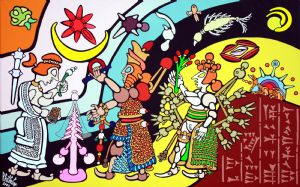| |

|

|
B103 - Seal TARIBA ISHTAR, who will carry the seal will remain in good health.
Other
Size: 125 x 190 cm - 49,2 x 74,8 inches
15.330 USD
Description:
BABYLONIAN / (Text translated by Google) - The scene is a neo-Assyrian, appeared before an adoring their gods with a present she holds in her right hand, this is a seal-cylinder representing the identical monogram PHILHELM on its six sides. On the other hand, it may be an artificial flower in precious metal. At his feet, totemic symbol of the god MARDUK. Which faces him, taking high the insignia of his power, the red circle and blue stick. In his left hand on another symbol whose meaning escapes me. From his back major emerging stars. The third character is the goddess ISHTAR which radiates a melammű of his whole being. She holds a bouquet in her right hand.
In the seven overlays Mesopotamian world (3 bunk heaven earth hell + 3 shots) are from left to right:
- A meteor - the crescent of the moon slept with the sun above - three stars in motion - a flying fish - a meteor - the sacred triangle - and a dog sitting with irradiation of planets. The final entry in cuneiform means: "Seal of TARIBA ISHTAR, who will wear the seal (-cylinder) will remain in good health."
TARIBA ISHTAR = From the Neo-Babylonian, some characters, especially the kings and some high priests, added the name of a god or goddess to them to assert their divine ancestry, sometimes dating back to the Wise antediluvian, the "APKALLU", creatures half-man, half fish. Regarding TARIBA ISHTAR it is very possible that he was a great eunuch (Issar = eunuch).
MARDUK = Quoted in the Bible under the name of BEL and MERODACH in the Old Testament. God's tutelary city of Babylon, but first the land God.
ISHTAR = Goddess supreme among Babylonians, Sumerians or INANNA in lez, sometimes regarded as the daughter of the God of rain, best known as the goddess of love free, she debased then killed her lovers after use (Epic of GILGAMESH). Every new year, the sovereign was obliged to "marry" one of the priestesses of the goddess, to ensure soil fertility and fecundity. This ritual called "sacred marriage or sacred marriage" was particularly widespread in the late third millennium.
MELAMMU = An unearthly glow emanating from asset and only one god and that radiates out like a jewel and is directly proportional to the power of divinity from which it originates and vitality he brought to light intensity. And until the word of God that shines in this radiation. Like everything that is sacred and holy splendor is quite fascinating, but also unbearable to be terrifying. The metaphysical level, the deity is felt as a phenomenon inspiring both respect and fear. This brightness is opposed to chaos and disorder that characterize the darkness and silence, because the brightness has antonym for the words and the concept of sleep, immobility and silence: it is both the sign and instrument power and sovereignty.
|
|

|
|